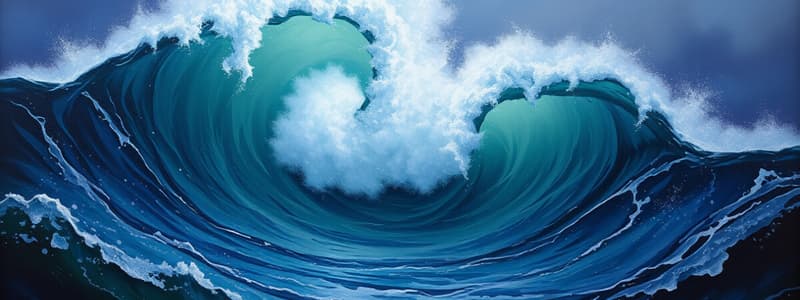Podcast
Questions and Answers
What causes ripples to form on the surface of the water?
What causes ripples to form on the surface of the water?
- The wind blowing over the sea (correct)
- The gravitational pull of the moon
- Temperature changes in the water
- The seabed structure beneath the water
What is the term for the distance the wind blows across the water?
What is the term for the distance the wind blows across the water?
- Tide
- Swash
- Current
- Fetch (correct)
What occurs when waves approach the shore?
What occurs when waves approach the shore?
- They develop horizontal movement (correct)
- They create a backwash only
- They cease to exist
- They maintain their circular motion
What is the term for the water that rushes up the beach?
What is the term for the water that rushes up the beach?
What are constructive waves known for?
What are constructive waves known for?
Which type of waves are preferred by surfers for longer rides?
Which type of waves are preferred by surfers for longer rides?
What happens to the circular motion of water as it approaches shallower water?
What happens to the circular motion of water as it approaches shallower water?
What natural events can cause tsunami waves?
What natural events can cause tsunami waves?
What is primarily responsible for the formation of waves in the sea?
What is primarily responsible for the formation of waves in the sea?
How does the fetch influence the power of waves?
How does the fetch influence the power of waves?
What happens to the waves as they approach the shore?
What happens to the waves as they approach the shore?
What is the term used to describe the water that flows back towards the sea after a wave has broken?
What is the term used to describe the water that flows back towards the sea after a wave has broken?
Which type of waves are characterized as being low and having a strong swash that contributes to beach construction?
Which type of waves are characterized as being low and having a strong swash that contributes to beach construction?
What is a significant effect of tsunami waves when they reach the coast?
What is a significant effect of tsunami waves when they reach the coast?
Which factors primarily determine the formation of constructive waves?
Which factors primarily determine the formation of constructive waves?
What common characteristic do constructive waves share that makes them favorable for surfers?
What common characteristic do constructive waves share that makes them favorable for surfers?
Flashcards are hidden until you start studying
Study Notes
Wave Formation
- Waves are created by wind blowing over the sea, generating friction with the water surface.
- Small ripples develop into larger waves as the wind continues to blow.
- The distance over which the wind blows on the water is known as "fetch"; longer fetch leads to more powerful waves.
- Tsunamis are large waves caused by underwater disturbances such as earthquakes or volcanic eruptions.
Tsunami Details
- In March 2011, a tsunami with waves up to 40 meters high struck the Japanese coast.
- This disaster caused significant destruction, leading to the death of over 20,000 people and the devastation of coastal settlements.
Behavior of Waves Near the Coast
- In open sea, water has minimal horizontal movement despite visible waves.
- As waves approach shore, forward movement occurs when they break and surge onto the beach.
- The seabed affects the circular motion of water; it becomes more elliptical as the water shallows, causing waves to rise and eventually crash onto the beach.
Wave Dynamics
- The water pushing up the beach is termed "swash," while the water returning to the sea is called "backwash."
- The interaction between waves and the seabed leads to the transformation of circular orbits into elliptical ones.
Types of Waves: Constructive Waves
- Constructive waves are characterized by low height and a powerful swash that deposits sand and pebbles on the beach.
- These waves help create and extend the beach area, contributing to coastal construction.
- Surfers favor constructive waves due to their longer rides; these waves often originate from distant storms.
Wave Formation
- Waves are primarily formed by wind blowing across the sea surface, creating friction and generating ripples.
- The distance over which the wind blows, known as the fetch, impacts wave strength; longer fetch equals more powerful waves.
- Tsunamis are large waves caused by seismic activities like earthquakes or volcanic eruptions, leading to significant alterations in the seabed.
- The March 2011 tsunami in Japan reached heights of up to 40 meters, resulting in over 20,000 deaths and widespread destruction of coastal settlements.
Behavior of Waves Near the Coast
- In open water, waves exhibit little horizontal movement; the primary motion is circular.
- As waves approach the shore, the forward motion of water increases when they break, causing water to surge up the beach as swash.
- The seabed's shallowness distorts the circular wave motion into more elliptical shapes, leading to the collapse of wave crests onto the beach.
- The backwash is the water that flows back towards the sea after reaching the shore.
Types of Waves
-
Constructive Waves
- Low-energy waves that surge and "spill" along the beach, producing a strong swash.
- They transport and deposit sand and pebbles, contributing to beach formation.
- Preferred by surfers due to longer rides, often generated by distant storms.
-
Destructive Waves
- Formed by local storms near the coast, characterized by close spacing and chaotic movement.
- High, steep waves plunge down onto the beach with minimal swash but significant backwash.
- Result in the erosion and gradual destruction of the beach, removing sand and pebbles.
Studying That Suits You
Use AI to generate personalized quizzes and flashcards to suit your learning preferences.




